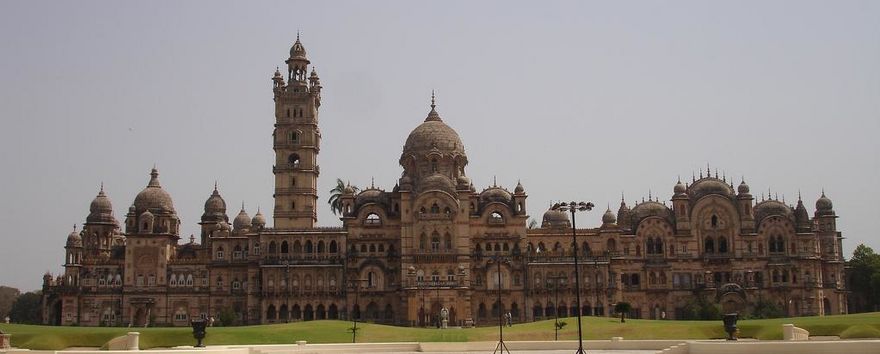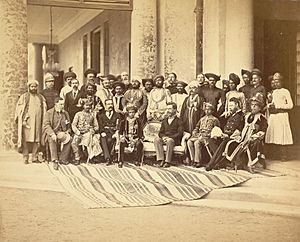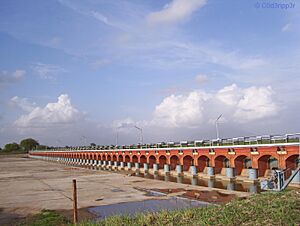Sayajirao Gaekwad III facts for kids
Quick facts for kids Sayajirao Gaekwad III |
|
|---|---|
| Farzand-i-Khas-i-Daulat-i-Inglishia, Shrimant Maharaja Sir , Sena Khas Khel Shamsher Bahadur Maharaja Gaekwad of Baroda, GCSI, GCIE, KIH | |
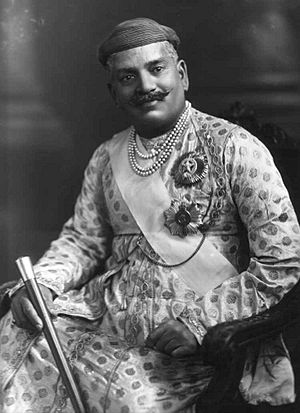
Sayajirao III Gaekwad, Maharaja of Baroda, 1919
|
|
| King of Baroda | |
| Reign | 10 April 1875 – 6 February 1939 |
| Coronation | 10 April 1875 (in Baroda) |
| Predecessor | Malhar Rao Gaekwad Madhav Rao Thanjavurkar (de facto) |
| Successor | Pratap Singh Rao Gaekwad |
| Born | 11 March 1863 |
| Died | 6 February 1939 (aged 75) |
| Consort | Chimnabai I Chimnabai II |
| Issue | Shrimant Maharajkumari Bajubai Gaekwad Shrimant Maharajkumari Putlabai Gaekwad Yuvaraj Sahib Fatehsinhrao Gaekwad Shrimant Maharajkumar Jaisinghrao Gaekwad Shrimant Maharajkumar Shivajirao Gaekwad Maharani Indira Devi Shrimant Maharajkumar Dhairyashilrao Gaekwad |
| Dynasty | Gaekwad |
| Father | Kashirao Gaekwad |
| Religion | Hinduism |
| Signature | |
Sayajirao Gaekwad III (born Shrimant Gopalrao Gaekwad; 11 March 1863 – 6 February 1939) was a very important ruler, known as the Maharaja of Baroda State. He ruled from 1875 to 1939. During his long rule, he made many big changes and improvements in his state. He was part of the royal Gaekwad dynasty of the Maratha people, who ruled parts of what is now Gujarat, India.
Contents
Early Life of Sayajirao Gaekwad III
Sayajirao was born as Gopalrao Gaekwad on March 11, 1863. His family was a kurmi maratha family from a village called Kavlana. He was the second son of Kashirao Bhikajirao and Ummabai. His family was a smaller branch of the Gaekwad dynasty. This meant he was not expected to become the ruler.
How Sayajirao Became King
After the popular ruler, Sir Khanderao Gaekwad, passed away in 1870, his brother, Malhar Rao Gaekwad, was expected to take the throne. However, Malharrao had caused many problems. He had even been put in prison before for trying to harm his brother.
Khanderao's wife, Maharani Jamnabai, was expecting a baby. So, the decision about who would rule was put on hold. When the baby was born on July 5, 1871, it was a girl. Because of this, Malharrao became the new ruler.
Malharrao spent a lot of money, almost emptying the state's treasury. He ordered very expensive items, like cannons made of solid gold. Reports also reached the British officials that Malharrao was a very harsh ruler. He even tried to poison a British officer named Robert Phayre.
Because of his bad actions, the British government removed Malharrao from power on April 10, 1875. He was sent away to Madras and died there later.
Choosing the Next Ruler
With the throne empty, Maharani Jamnabai invited leaders from different parts of the royal family. They came to Baroda to present themselves and their sons. They wanted to choose the next ruler.
Kashirao and his three sons, Anandrao, Gopalrao, and Sampatrao, walked about 600 kilometers to Baroda. When asked why he had come, young Gopalrao bravely said, "I have come here to rule."
The British chose Gopalrao as the next ruler. Maharani Jamnabai officially adopted him on May 27, 1875. He was given a new name, Sayajirao. He became the king on June 16, 1875. Since he was still young, a group of people ruled for him.
He was given full ruling powers on December 28, 1881. During his younger years, he was taught a lot about how to govern by Raja Sir T. Madhava Rao. Madhava Rao helped Sayajirao become a wise leader who cared about his people. He also helped bring the state back to normal after Malharrao's difficult rule.
Sayajirao's Rule and Modern Changes
When Sayajirao took full control, he focused on many important things. He worked to educate his people and help those who were struggling. He also made big changes in law, farming, and society.
Important Reforms and Developments
Sayajirao played a key role in making Baroda's textile industry strong. He also brought in many educational and social reforms. These included:
- Stopping child marriage.
- Making divorce legal.
- Ending the practice of untouchability.
- Spreading education to more people.
- Supporting the study of Sanskrit and other important subjects.
- Encouraging fine arts like music and painting.
He also started new economic projects. He helped build a railway system (see below). In 1908, he founded the Bank of Baroda. This bank is still one of India's biggest banks today.
Sayajirao knew he was a Maratha ruler in Gujarat. He connected with his people and encouraged them to be open-minded and eager for change. His large personal library became the start of today's Central Library of Baroda. This library system spread to all towns and villages in his state.
In 1906, he was the first Indian ruler to make primary education free and required for everyone in his state. This put Baroda far ahead of other parts of British India at that time.
To honor his vision and leadership, the Baroda Management Association created the Sayaji Ratna Award in 2013.
Sayajirao's Views and Challenges
Even though he was a prince of an Indian state, Sayajirao strongly defended his rights and position. This sometimes led to disagreements with the British government. He often had debates with British officials and even the Viceroy (the highest British official in India).
He was given the special title of Farzand-i-Khas-i-Daulat-i-Inglishia ("Favoured Son of the English Nation") in 1876. He attended grand ceremonies called Delhi Durbars in 1877, 1903, and 1911. An event at the 1911 Delhi Durbar caused some trouble between Sayajirao and the British.
The Delhi Durbar of 1911
The 1911 Delhi Durbar was a very important event. King George V of Britain, the first reigning British monarch, traveled to India for it. Each Indian ruler was expected to show respect to the King-Emperor. They were supposed to bow three times and then walk backward without turning their back.
Sayajirao was the third most important Indian ruler to approach the King-Emperor. He had already upset British officials by not wearing all his royal jewels and honors. While some stories say he refused to bow, Sayajirao did bow once, but quickly. Then he turned his back on the King-Emperor. His granddaughter, Gayatri Devi, later wrote that he might have missed rehearsals and didn't know the proper way to greet the King. Other people said he walked away "laughing."
For several years, Sayajirao had already made the British unhappy by openly supporting the Indian National Congress and its leaders. The incident at the Durbar was the final straw. The British never fully trusted Sayajirao again. However, he was publicly forgiven and received another honor in 1919.
He also gave money to help build the Central Library at Banaras Hindu University. This library is now named "Sayaji Rao Gaekwad Central Library" after him.
Public Works and Improvements
Railways and Water Systems
During his time as ruler, a large narrow-gauge railway network was greatly expanded. This network had started in 1862 with Dabhoi as its main point. Today, it is still the largest narrow-gauge railway network in the world.
In 1892, Sayajirao planned a water supply system for Baroda at Ajwa. This system would use gravity to bring drinking water to the people. Even today, a big part of Vadodara City gets its drinking water from this source.
Parks and Universities
The large public park, first called Kamati Baug and now known as Sayaji Baug, was a gift from him to the city of Vadodara. When he celebrated 60 years on the throne, he set aside a lot of money from his personal and state funds. This money was for building a university in Vadodara for students from rural areas. His grandson, Sir Pratap Singh Rao Gaekwad, later completed this task. He founded the Maharaja Sayajirao University and set up a trust, as his grandfather wished. This trust helps with education and other needs for people from the former state of Baroda.
Supporting Talented People
Sayajirao was very good at finding talented people among his subjects. He supported their education and training if he believed they would do great things. Some of the famous people he helped included:
- Dr. Babasaheb alias Bhimrao Ramji Ambedkar: He later led the committee that wrote the Indian Constitution.
- Vitthal Ramji Shinde: He started the "Mission to the depressed class" and was an important social reformer.
- Dadabhai Naoroji: He started his public life as a minister to the Maharaja in 1874. He later became the first Asian member of the British House of Commons. There, he openly said he also represented the people of India.
Sayajirao also sent his Agriculture Commissioner, Chintaman Vishnu Sane, to the United States for research in farming. He appointed V. T. Krishnamachari as the Diwan (chief minister) of Vadodara.
Sayajirao used to visit England every year to find bright young people for his service. On one such visit, he met 20-year-old Sri Aurobindo. He immediately offered him a job at Baroda College. Sri Aurobindo returned to India in 1893 to work for Baroda. Another Bengali writer, Syed Mujtaba Ali, also taught there.
Cultural Interests
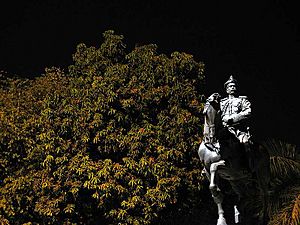
The Maharaja loved and supported the arts. During his rule, Baroda became a center for artists and scholars. The famous painter, Raja Ravi Varma, spent a lot of time at his court.
Science and Research
Sayajirao paid for research and publications by James Hornell on Marine Biology. This work is still an important source of information today.
Jewellery Collection
Sayajirao had a magnificent collection of jewels. This included famous diamonds like the "Star of the South," the "Akbar Shah," and the "Princess Eugenie."
Indian Classical Music
Sayajirao also supported Indian classical music. Ustad Moula Bux started the Academy of Indian Music (Gayan Shala) with his help in 1886. This Academy later became the Music College. It is now part of the Faculty of Performing Arts of the Maharaja Sayajirao University of Vadodara.
Besides Ustad Moula Bux, Sayajirao's court had other great artists. These included Abdul Karim Khan, Inayat Khan, and Ustad Faiyaz Khan. In 1916, the first All India Music Conference was held in Baroda.
Dance
The Maharaja Sayajirao University of Vadodara started the first dance program in India in 1950. Over the years, there were many connections between Baroda's kings and princesses. Musicians and dancers were often part of cultural exchanges. Having many artists was a sign of status for royal courts.
In 1880, Maharani Laksmi Bai (Chimnabai I) of Tanjore married Maharaja Sayajirao III. Chimnabai I knew a lot about Bharatanatyam and Carnatic music. When she married, she brought a dance group with her. This group included dancers, nattuvanars (Bharatanatyam concert leaders), and teachers. Other dancers and teachers followed later.
Sayajirao's Family
Maharaja Sayajirao first married Shrimant Lakshmibai Mohite of Tanjore (who became Chimnabai I) on January 6, 1880. They had a son and two daughters:
- 1. Shrimant Maharajkumari Bajubai Gaekwad (1881–1883)
- 2. Shrimant Maharajkumari Putlabai Gaekwad (1882–1885)
- 3. Shrimant Yuvaraja Fatehsinhrao Gaekwad (1883–1908). He passed away young. He had a son and two daughters, including:
- Pratap Singh Rao Gaekwad, who became the next Maharaja of Baroda in 1939.
His first wife passed away young. Sayajirao then married Shrimant Gajrabai (1871–1958) on December 28, 1885. She became Chimnabai II after their wedding. She was a strong supporter of rights for Indian women. She was as determined and capable as her husband during their 53 years of marriage. They had several sons and one daughter:
- 1. Shrimant Maharajkumar Jaisinghrao Gaekwad (1888–1923); he had no children.
- 2. Shrimant Maharajkumar Shivajirao Gaekwad (1890–1919); he had two sons and one daughter.
- 3. Maharani Indira Devi (1892–1968). She married Jitendra Narayan in 1911 and had children. Her descendants include the models Riya Sen and Raima Sen. She became a Maharani Regent of Cooch Behar and was the mother of Gayatri Devi of Jaipur.
- 4. Shrimant Maharajkumar Dhairyashilrao Gaekwad (1893–1940); he had three sons and two daughters.
Other family members of Sayajirao married into royal families of other states like Kolhapur and Gwalior.
Death
After a long and impactful rule of 63 years, Sayajirao Gaekwad III passed away on February 6, 1939. He was almost 76 years old. His grandson and chosen heir, Pratap Singh Rao Gaekwad, became the next Maharaja of Baroda.
Images for kids
-
Maharaja Sayaji Rao, portrait by Raja Ravi Varma.
See also
- Bank of Baroda
- Baroda Museum and Picture Gallery
- Sayaji Rao Gaekwad Library (Central Library), BHU
- Princely State
- Maratha Empire
- Sayaji Ratna Award





